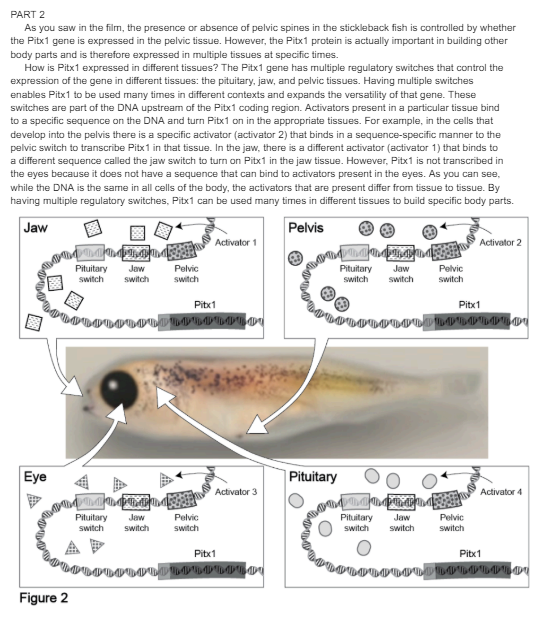Figure 2 illustrates how Pitx1 transcription is regulated in different tissues. The center image is that of a stickleback embryo. The drawings in the surrounding boxes show the Pitx1 gene region and activator proteins present in the jaw, pelvis, eye, or pituitary tissues. Note that for simplicity, we are only showing one activator molecule present in a particular tissue. In reality, many activators are present in a particular tissue at any one time. Activator molecules with specific shading can bind to switches with the same shading. 1. List all the tissues shown in Figure 2 that express the Pitx1 gene.
Figure 2 illustrates how Pitx1 transcription is regulated in different tissues. The center image is that of a stickleback embryo. The drawings in the surrounding boxes show the Pitx1 gene region and activator proteins present in the jaw, pelvis, eye, or pituitary tissues. Note that for simplicity, we are only showing one activator molecule present in a particular tissue. In reality, many activators are present in a particular tissue at any one time. Activator molecules with specific shading can bind to switches with the same shading. 1. List all the tissues shown in Figure 2 that express the Pitx1 gene.
Concepts of Biology
1st Edition
ISBN:9781938168116
Author:Samantha Fowler, Rebecca Roush, James Wise
Publisher:Samantha Fowler, Rebecca Roush, James Wise
Chapter9: Molecular Biology
Section: Chapter Questions
Problem 10RQ: Control of gene expression in eukaryotic cells occurs at which level(s)? a. only the transcriptional...
Related questions
Topic Video
Question
100%
Part 2 Bio Question 1

Transcribed Image Text:Figure 2 illustrates how Pitx1 transcription is regulated in different tissues. The center image is that of a
stickleback embryo. The drawings in the surrounding boxes show the Pitx1 gene region and activator proteins
present in the jaw, pelvis, eye, or pituitary tissues. Note that for simplicity, we are only showing one activator
molecule present in a particular tissue. In reality, many activators are present in a particular tissue at any one
time. Activator molecules with specific shading can bind to switches with the same shading.
1. List all the tissues shown in Figure 2 that express the Pitx1 gene.

Transcribed Image Text:PART 2
As you saw in the film, the presence or absence of pelvic spines in the stickleback fish is controlled by whether
the Pitx1 gene is expressed in the pelvic tissue. However, the Pitx1 protein is actually important in building other
body parts and is therefore expressed in multiple tissues at specific times.
How is Pitx1 expressed in different tissues? The Pitx1 gene has multiple regulatory switches that control the
expression of the gene in different tissues: the pituitary, jaw, and pelvic tissues. Having multiple switches
enables Pitx1 to be used many times in different contexts and expands the versatility of that gene. These
switches are part of the DNA upstream of the Pitx1 coding region. Activators present in a particular tissue bind
to a specific sequence on the DNA and turn Pitx1 on in the appropriate tissues. For example, in the cells that
develop into the pelvis there is a specific activator (activator 2) that binds in a sequence-specific manner to the
pelvic switch to transcribe Pitx1 in that tissue. In the jaw, there is a different activator (activator 1) that binds to
a different sequence called the jaw switch to turn on Pitx1 in the jaw tissue. However, Pitx1 is not transcribed in
the eyes because it does not have a sequence that can bind to activators present in the eyes. As you can see,
while the DNA is the same in all cells of the body, the activators that are present differ from tissue to tissue. By
having multiple regulatory switches, Pitx1 can be used many times in different tissues to build specific body parts.
Jaw
Pelvis
Activator 1
Eye
A
Pituitary Jaw
switch
Pelvic
switch
switch
Figure 2
Pituitary
switch
Pitx1
QOLOLOLOLOLOL
Jaw
switch
Pelvic
switch
Activator 2
Pituitary
switch
Jaw
Pelvic
switch
switch
Pituitary
Activator 3
Pitx1
LOLOLOLOLOLOU
Pituitary Jaw
switch switch
Pitx1
Activator 4
Pelvic
switch
Pitx1
OLOLOLOLOLOU
Expert Solution
This question has been solved!
Explore an expertly crafted, step-by-step solution for a thorough understanding of key concepts.
Step by step
Solved in 4 steps

Knowledge Booster
Learn more about
Need a deep-dive on the concept behind this application? Look no further. Learn more about this topic, biology and related others by exploring similar questions and additional content below.Recommended textbooks for you

Concepts of Biology
Biology
ISBN:
9781938168116
Author:
Samantha Fowler, Rebecca Roush, James Wise
Publisher:
OpenStax College

Biology 2e
Biology
ISBN:
9781947172517
Author:
Matthew Douglas, Jung Choi, Mary Ann Clark
Publisher:
OpenStax

Concepts of Biology
Biology
ISBN:
9781938168116
Author:
Samantha Fowler, Rebecca Roush, James Wise
Publisher:
OpenStax College

Biology 2e
Biology
ISBN:
9781947172517
Author:
Matthew Douglas, Jung Choi, Mary Ann Clark
Publisher:
OpenStax